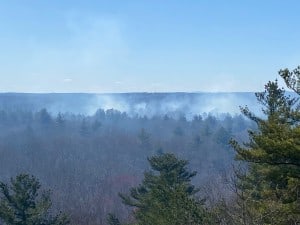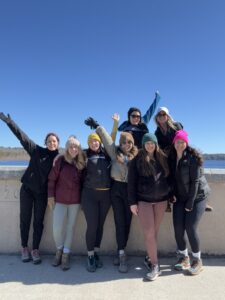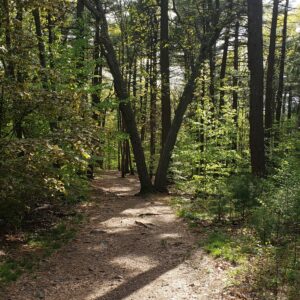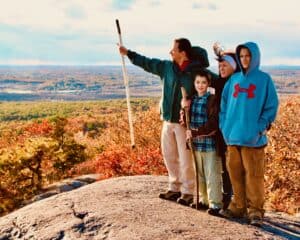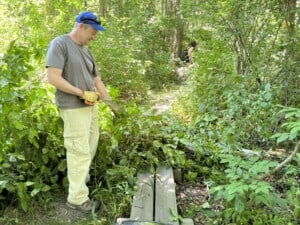By Michael Morgan
It has stood sentry near the top of Great Blue Hill for some 85 years now, offering stunning, 270- degree views of Boston Harbor, the City of Boston and the South Shore. It has endured snow, rain, ice, burning sun, vandalism, fire and the footsteps of millions of visitors. Now the Eliot Tower and its adjoining pavilion is getting a well-deserved rest and some tender loving care; the first comprehensive renovation and restoration project since its construction. The Friends has long advocated for state funding to repair Eliot Tower and other historic buildings.
According to Lt. Tom Bender of the Massachusetts Department of Conservation and Recreation (DCR), the currently closed 35-foot tower is undergoing repairs that include “repointing” – the repair of mortar in all the tower’s stones – as well as replacement of its fireplace and dismantling and rebuilding its chimney. In addition, workers are adding exterior handrails while making the interior handrails compliant with state and town building codes and constructing a wheelchair accessible ramp to the adjacent pavilion and resurfacing of the pavilion floor. Planning for the project began “a couple of years ago,” while actual work began in early July and is now “going full bore,” said Bender, who has been working in the Blue Hills for 20 years.

Eliot Tower from above.
Built by the Civilian Conservation Corps (CCC) during the administration of President Franklin Roosevelt, the tower and pavilion the Eliot Tower work is “moving pretty quickly now.” It is named for architect and nature/recreation advocate Charles Eliot, who was an associate of Frederick Laws Olmstead – the designer of Boston and New York City park systems. Bender said Eliot was a strong supporter of setting aside park areas outside the city for local residents and that Eliot’s efforts dating to the 1890s resulted in “the first regional park system in the United States.” He explained that in 1895, four reservations in the Greater Boston area were planned, two south of Boston (Blue Hills, Stoney Brook) and two to the north (Beaver Brook and the Fells). He added that “during the 1910s” the former Metropolitan District Commission “designed and constructed parkways for Sunday pleasure drives” between all the parks.
From 1933 to 1937, the Blue Hills was home to an encampment of the CCC, with a “satellite camp” in its place as construction work on the tower and pavilion began in 1937. Construction on the tower and pavilion were complete by 1939 and a storeroom was added to the pavilion area during the 1950s. Bender said the room was used to store an electric generator, call box and radio for use as the Blue Hills first communications system. This room is being removed as part of the current renovations. There were two, brief earlier phases of renovation; one was for roof replacement in 2016. Bender said the original roof had been made of slate but was later replaced with a “plastic slate” compound made of rubber and plastic. He pointed out that for two years in the early 1980s, there had been no roof at all as “kids had blown the roof off the structure” but the vandals were never caught. The US Army Corps of Engineers then came in to do a redesign with a “faux slate roof” constructed.

A second phase of renovation took place two years ago with some landscaping work, but Bender said that the important stone repointing was delayed until this year because this work in the main areas represented a major investment in the future. “It’s a long process,” he observed. “The repointing keeps the water (from storms) out of the rocks. The mortar has to be tested for strength and the proper mixture at our concrete testing lab” and there is a weekly meeting to discuss the progress. Also in progress is the replacement of the fireplace and chimney but he noted that the replacement is more for aesthetic purposes as “there will be no fires.” There will instead be a metal plate added to ensure the fireplace cannot be illegally used.
But not being able to stand by the fire is a small price to pay for the privilege of once again climbing the tower and “enjoying the view and the breeze.” Asked if there had ever been any ceremonies such as weddings spreading ashes of beloved deceased Blue Hills fans, Bender said “No weddings that we know of but I’m sure some engagements have happened there.” And he said he would not be surprised if some ashes had been sprinkled in surreptitious ceremonies. As for a reopening ceremony, Bender said there was no formal event planned but there may be “a soft opening, possibly this fall, or by Christmas.” After all, good things come to those who wait.
Top photo: Jasmine Smith (Stoughton)


